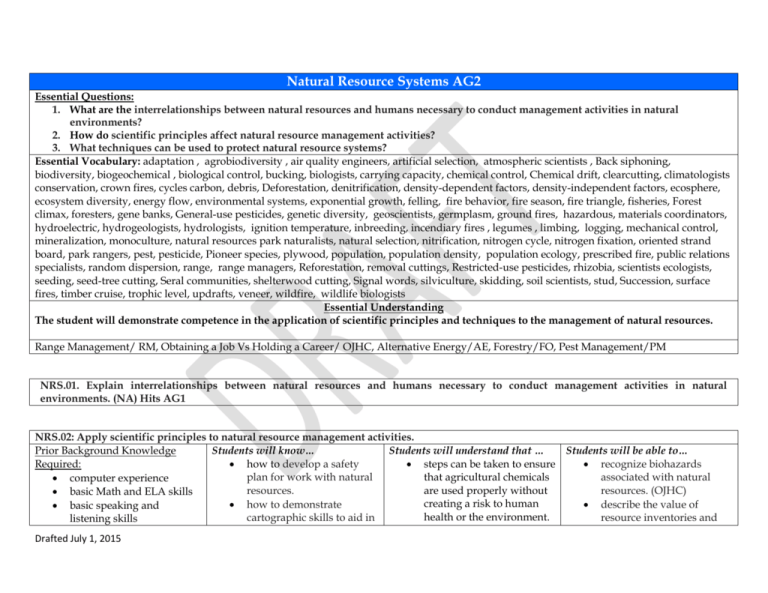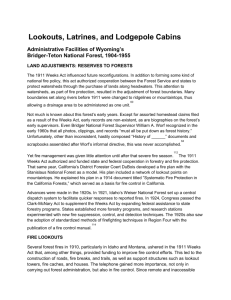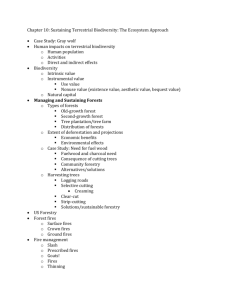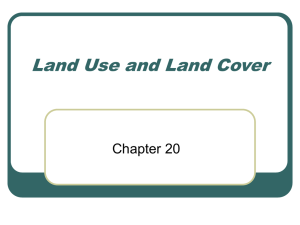Natural Resource Systems AG2
advertisement

Natural Resource Systems AG2 Essential Questions: 1. What are the interrelationships between natural resources and humans necessary to conduct management activities in natural environments? 2. How do scientific principles affect natural resource management activities? 3. What techniques can be used to protect natural resource systems? Essential Vocabulary: adaptation , agrobiodiversity , air quality engineers, artificial selection, atmospheric scientists , Back siphoning, biodiversity, biogeochemical , biological control, bucking, biologists, carrying capacity, chemical control, Chemical drift, clearcutting, climatologists conservation, crown fires, cycles carbon, debris, Deforestation, denitrification, density-dependent factors, density-independent factors, ecosphere, ecosystem diversity, energy flow, environmental systems, exponential growth, felling, fire behavior, fire season, fire triangle, fisheries, Forest climax, foresters, gene banks, General-use pesticides, genetic diversity, geoscientists, germplasm, ground fires, hazardous, materials coordinators, hydroelectric, hydrogeologists, hydrologists, ignition temperature, inbreeding, incendiary fires , legumes , limbing, logging, mechanical control, mineralization, monoculture, natural resources park naturalists, natural selection, nitrification, nitrogen cycle, nitrogen fixation, oriented strand board, park rangers, pest, pesticide, Pioneer species, plywood, population, population density, population ecology, prescribed fire, public relations specialists, random dispersion, range, range managers, Reforestation, removal cuttings, Restricted-use pesticides, rhizobia, scientists ecologists, seeding, seed-tree cutting, Seral communities, shelterwood cutting, Signal words, silviculture, skidding, soil scientists, stud, Succession, surface fires, timber cruise, trophic level, updrafts, veneer, wildfire, wildlife biologists Essential Understanding The student will demonstrate competence in the application of scientific principles and techniques to the management of natural resources. Range Management/ RM, Obtaining a Job Vs Holding a Career/ OJHC, Alternative Energy/AE, Forestry/FO, Pest Management/PM NRS.01. Explain interrelationships between natural resources and humans necessary to conduct management activities in natural environments. (NA) Hits AG1 NRS.02: Apply scientific principles to natural resource management activities. Students will know… Students will understand that … Students will be able to… Prior Background Knowledge Required: how to develop a safety steps can be taken to ensure recognize biohazards plan for work with natural that agricultural chemicals associated with natural computer experience resources. are used properly without resources. (OJHC) basic Math and ELA skills creating a risk to human how to demonstrate describe the value of basic speaking and health or the environment. cartographic skills to aid in resource inventories and listening skills Drafted July 1, 2015 basic collaboration tools developing, implementing and evaluating natural resource management plans. how measure and survey natural resource status to obtain planning data. how to demonstrate natural resource enhancement techniques. how to interpret laws related to natural resource management and protection. How to apply ecological concepts and principles to natural resource systems. Mycaert.com NRES:A1-3 NRES:B1-2 NRES:B1-4 NRES:C2-3 NRES:E1-2 Agednet.com NR122 NR175 NR150 NR151 Vocabulary: air quality engineers atmospheric scientists back siphoning biogeochemical Drafted July 1, 2015 while it takes many years for forests to become established and grow to maturity, forest renewal continues to take place. Trees can and are being planted to get new forests started. each year a succession of new types of plants is added to the mix and begins to compete with existing plants for light, moisture and nutrients. Gifford Pinchot is credited with the concept of "greatest good for the greatest number" in forest management. many careers related to natural resources and environmental systems are available. a population is a group of individuals of the same species sharing the same geographic area. the biosphere, consisting of all the communities of organisms, together with the interactions of the organisms with the hydrosphere, lithosphere, and atmosphere, is the ecosphere. the cycles of elements population studies. (RM) discuss the procedures for conducting resource inventories and population studies. (RM) conduct resource inventories and population studies to assess resource status. (RM) identify characteristics of a healthy forest. (FO) identify ways in which forest stands may be improved. (FO) formulate a timber stand improvement plan for a forest. (FO) identify characteristics of healthy rangeland. (RM) identify methods of rangeland improvement. (RM) evaluate a rangeland and develop a management plan for improvement. (RM) identify natural resource characteristics desirable for recreational purposes. (RM, FO) identify laws associated with natural resource systems. (RM, FO) identify the purposes of laws associated with natural resource systems. Drafted July 1, 2015 carrying capacity chemical drift climatologists conservation cycles carbon deforestation denitrification density-dependent factors density-independent factors ecosphere energy flow environmental systems exponential growth fisheries biologists Forest climax foresters general-use pesticides geoscientists hazardous materials coordinators hydrogeologists hydrologists legumes mineralization natural resources park naturalists nitrification nitrogen cycle nitrogen fixation park rangers pioneer species population population density population ecology public relations specialists through the biotic (living) and abiotic (nonliving) parts of the earth are referred to as biogeochemical cycles. rangeland is the dominant ecosystem in much of the western half of North America. some of the goods and services obtained from rangeland are livestock forage, wildlife habitat, water, mineral resources, wood products, wildland recreation, open space, and natural beauty. outdoor recreation includes any activity a person does in the outdoors for enjoyment that involves natural resources and/or wildlife. (RM, FO) describe the processes associated with ecological succession. (FO) give examples of primarysuccession and secondarysuccession species in a community of organisms. (FO) define invasive species. (FO, PM) discuss factors that influence the establishment and spread of invasive species. (FO, PM) random dispersion range range managers reforestation restricted-use pesticides rhizobia scientists ecologists seral communities signal words soil scientists succession trophic level wildlife biologists NRS.03. Apply knowledge of natural resources to production and processing industries. Students will know… Students will understand that … Prior Background Knowledge Required: how to produce, harvest, diversity is extremely process and use natural important to Earth and the computer experience resource products. living organisms on Earth. basic Math and ELA skills biodiversity provides a basic speaking and Mycaert.com reservoir of resources to be listening skills NRES:B1-5 drawn from for food, basic collaboration tools NRES:C1-7 medication, and industry. NRES:C1-15 silvicultural plans involve the proper use of logging. Vocabulary: harvesting or logging is the adaptation process by which agrobiodiversity individuals remove trees artificial selection from the forest to make wood products. biodiversity bucking the harvesting of trees involves a number of clearcutting activities. ecosystem diversity the cost of logging is a felling Drafted July 1, 2015 Students will be able to… describe forest harvesting methods. (FO) determine when to harvest forest products. (FO) describe uses of tree species. (FO) describe processing of forest products. (FO) describe the value of fossil fuels to the economy. (AE) describe sources of fossil fuels and products made from fossil fuels. (AE) describe the benefits of hydroelectric generation. (AE) describe characteristics of sites that lend themselves gene banks genetic diversity germplasm hydroelectric inbreeding limbing logging monoculture natural selection oriented strand board plywood removal cuttings seed-tree cutting shelterwood cutting silviculture skidding stud timber cruise veneer NRS.04: Demonstrate techniques used to protect natural resources. Students will know… Prior Background Knowledge Required: how to manage fires in natural resource systems. computer experience how to diagnose plant and basic Math and ELA skills wildlife diseases and follow basic speaking and protocol to prevent their listening skills spread. basic collaboration tools how to manage insect infestations of natural resources. Drafted July 1, 2015 major factor in the production of wood products. the activities associated with logging require people skilled in woods work and the operation of logging equipment. once logs or bolts reach a wood-using firm, they may be debarked, sawed, shaped, peeled, cooked, burned, glued, or dried. some of the most common examples of renewable energy resources include hydropower, solar, wind and biomass energy from plant or animal materials. hydropower is fourth as a source of electricity generation. Students will understand that … fuel, oxygen, and heat (the fire triangle)are required for a forest fire to Lesson: natural forces and human activities cause forest fires. safety concerns associated with prescribed burns include personal safety, public safety, and weather. the USDA Forest Service to hydroelectric generation.(AE) identify recreational uses of natural resources. (RM, FO) Students will be able to… differentiate between desirable and undesirable fires and prepare a report on the role fire plays in a healthy ecosystem. products. (FO) describe techniques used to suppress wildfires and manage prescribed fires. (FO) Mycaert.com NRES:C1-6 Agednet.com NR190 NR192 Vocabulary: biological control chemical control crown fires debris fire behavior fire season fire triangle ground fires ignition temperature incendiary fires mechanical control pest pesticide prescribed fire seeding surface fires updrafts wildfire categorizes forest fires into three general types: surface, ground, and crown. fire has an impact on life cycles of trees and plant communities. burning can be especially useful in managing pine stands and has multiple uses. there is a long list of insect and disease enemies that can infect and damage forest trees. the first things to consider in deciding how to control a forest pest are your overall forest management goals and objectives. NRS.05: Use effective methods and venues to communicate natural resource processes to the public. (NA) Drafted July 1, 2015 identify harmful and beneficial insects and signs of insect damage to natural resources. (RM, FO, PM) report observance of insect pests to the appropriate authorities. (PM)








